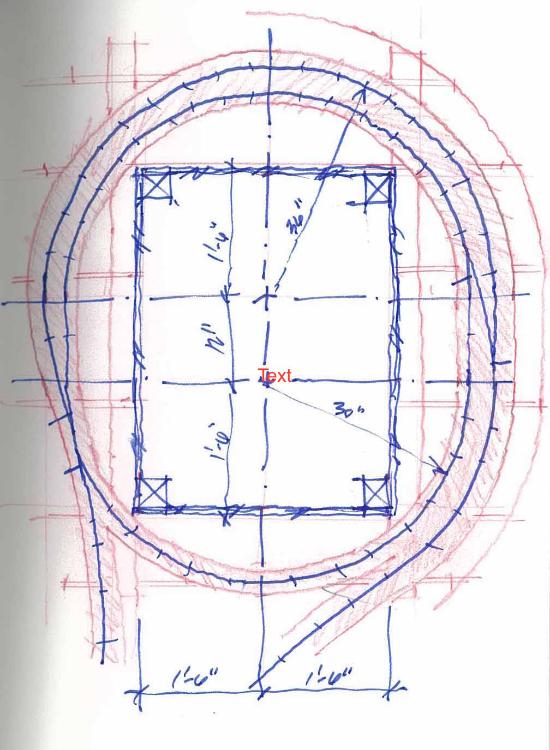The Helix
Posted by Keith Hayes on Nov 01, 2017; 12:37am
URL: http://c-sng-discussion-forum.254.s1.nabble.com/The-Helix-tp9915.html
I think it is safe to say we all have a model railroad vision that is larger than the space we have to build in. My own basement is an ‘L’ shape, about 24’ along each of the long legs. Mapping out a plan, developing a double deck seemed to be the best way to pack my chunk of the South Park into the space. And this required a method to get from one deck to the next: I choose a helix.
Helices seem to be controversial: they eat up a lot of track, and potentially hide the train for a long period. No doubt, if I had the space I would expose the grade the whole way, but I don’t have that luxury. So, I have been considering a helix: more on the details of the helix later.
As I have built the layout it appeared easiest to build the layout from the top down, starting in Leadville. Contemplating the helix, this requires construction from the bottom up. The early premise for the layout involved a return loop under the helix that would comprise east end staging (two consecutive sidings). At one time, this was D&RGW staging, but as my modeling interest has focused on the South Park, the staging will now represent Como and points east. Being the South Park in the 1930s, staging requirements are minimal—just the Denver-Leadville passenger train (maximum three cars and a locomotive, about 48”; and a west bound freight train (could be multiple locomotives and multiple cars—a two car train could be 84” to 96” long or so). The staging will be built first, and it could be a while until I connect the track to the rest of the layout, so I pondered how I could make this useful in the short run (pardon the pun).
Then it occurred to me to use the inner track to create a loop that can function as a test track until the railhead gets past Breckenridge. (see the drawing) In this case, both the sidings are about the same size—about 94” long. The first train into staging pulls into the bottom of the loop, and this leaves the upper portion free for a second train (and then both trains may escape when the time comes). The intent is that this track is level, so it will serve nicely as a test loop.

I will leave construction of the helix support structure for another post. Suffice to say that I observe that torsion control (the helix is a spring, and subject to small, rotational forces) is an issue that I would like to address in an elegant fashion. The plan is to construct an inner frame with a couple ‘L’ girders (like a sedan chair) which will support the benchwork for the helix.
URL: http://c-sng-discussion-forum.254.s1.nabble.com/The-Helix-tp9915.html
I think it is safe to say we all have a model railroad vision that is larger than the space we have to build in. My own basement is an ‘L’ shape, about 24’ along each of the long legs. Mapping out a plan, developing a double deck seemed to be the best way to pack my chunk of the South Park into the space. And this required a method to get from one deck to the next: I choose a helix.
Helices seem to be controversial: they eat up a lot of track, and potentially hide the train for a long period. No doubt, if I had the space I would expose the grade the whole way, but I don’t have that luxury. So, I have been considering a helix: more on the details of the helix later.
As I have built the layout it appeared easiest to build the layout from the top down, starting in Leadville. Contemplating the helix, this requires construction from the bottom up. The early premise for the layout involved a return loop under the helix that would comprise east end staging (two consecutive sidings). At one time, this was D&RGW staging, but as my modeling interest has focused on the South Park, the staging will now represent Como and points east. Being the South Park in the 1930s, staging requirements are minimal—just the Denver-Leadville passenger train (maximum three cars and a locomotive, about 48”; and a west bound freight train (could be multiple locomotives and multiple cars—a two car train could be 84” to 96” long or so). The staging will be built first, and it could be a while until I connect the track to the rest of the layout, so I pondered how I could make this useful in the short run (pardon the pun).
Then it occurred to me to use the inner track to create a loop that can function as a test track until the railhead gets past Breckenridge. (see the drawing) In this case, both the sidings are about the same size—about 94” long. The first train into staging pulls into the bottom of the loop, and this leaves the upper portion free for a second train (and then both trains may escape when the time comes). The intent is that this track is level, so it will serve nicely as a test loop.

I will leave construction of the helix support structure for another post. Suffice to say that I observe that torsion control (the helix is a spring, and subject to small, rotational forces) is an issue that I would like to address in an elegant fashion. The plan is to construct an inner frame with a couple ‘L’ girders (like a sedan chair) which will support the benchwork for the helix.
Keith Hayes
Leadville in Sn3
Leadville in Sn3
| Free forum by Nabble | Edit this page |